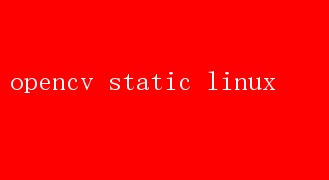OpenCV静态库在Linux上的安装指南
opencv static linux
作者:IIS7AI 时间:2025-01-09 21:07

OpenCV Static Libraries on Linux: A Comprehensive Guide for Developers In the vast landscape of computer vision and image processing libraries, OpenCV stands as a towering giant. With its rich feature set, robust algorithms, and extensive documentation, OpenCV has become the go-to choice for developers across various domains. Whether youre working on facial recognition, autonomous driving, or real-time video processing, OpenCV has the tools you need. One of the key decisions youll face when integrating OpenCV into your Linux-based project is whether to use the static or dynamic libraries. While dynamiclibraries (shared libraries) offer certain advantages in terms of memory usage and updates, static libraries(statically linkedlibraries) provide a level of control and stability that can be invaluable in certain scenarios. In this article, well delve into the intricacies of using OpenCV static libraries on Linux, highlighting their benefits, installation steps, and tips for efficient use. The Advantages of Static Libraries Before we dive into the specifics of setting up OpenCV static libraries on Linux, lets understand why you might prefer them over dynamic libraries. 1.Dependency Management: Static linking embeds all necessary code directly into your executable. This eliminates the need for external dependencies, making your application more portable and easier to distribute. You dont have to worry about library versions or compatibility issues on target machines. 2.Performance: While the performance difference between static and dynamic libraries is often negligible, static linking can sometimes result in slightly faster execution due to reduced overhead from dynamic linking and potential elimination of certain runtime checks. 3.Security: Static linking can improve security by reducing the attack surface. Since all code is bundled within the executable, theres no risk of an attacker exploiting vulnerabilities in shared libraries that your application depends on. 4.Consistency: Static linking ensures that the version of the library your application uses is the one you tested against. This can prevent subtle bugs caused by unexpected changes in library behavior across versions. Setting Up OpenCV Static Libraries on Linux Now, lets walk through the process of installing and configuring OpenCV static libraries on a Linux system. Step 1: Install Dependencies Before compiling OpenCV from source, you need to install some essential dependencies. These include build tools, libraries, and headers required for compilation. sudo apt-get update sudo apt-get install build-essential cmake git libgtk2.0-dev pkg-config libavcodec-dev libavformat-dev libswscale-dev sudo apt-get install python3-dev python3-numpy libtbb2 libtbb-dev libjpeg-dev libpng-dev libtiff-dev sudo apt-get install libdc1394-22-dev Step 2: Download OpenCV Source Code Next, clone the OpenCV repository from GitHub. This will give you the latest development version. If you need a specific release, you can download a tarball from the OpenCV website instead. cd ~ git clone https://github.com/opencv/opencv.git cd opencv git checkout